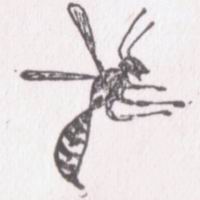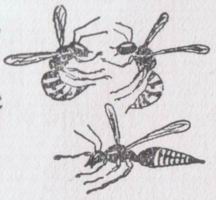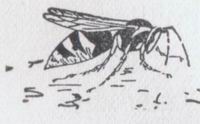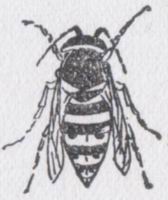|
1999-2004 (Return to Web Text-ures) |
Click Here to return to |
|
1999-2004 (Return to Web Text-ures) |
Click Here to return to |
PART I
THE SOCIAL WASPS
OR
VESPIDAE
VESPA, THE PAPER-MAKER.
“VESPA, the wasp, is an angrie creature," says
an old writer.
“Vespa, the wasp, is an angry creature,” says every writer, old or new, who has ; said anything about it.
One would think she did nothing from morning till night but sting.
Listen to the Ettrick Shepherd, --
“O' a' God's creatures, the wasp is the only ane that's eternally out o' temper; there's nae sic thing as pleasin' him.”
Then he describes a pleasant scene in the garden with the birds and bees in the sunshine, and again bursts out, --
 “Amid the general dance and minstrelsy, in comes
a shower o' infuriate wasps, red hot, as if let out of a fiery furnace, picking
quarrels wi' their ain shadows; then roun' and roun' the hair o' your head,
bizzing against the drum o' your ear, dashing against the face o' you, who are
wishin' ill to nae leevin' thing; and although you are engaged out to dinner,
stickin' a lang, poishoned stang in just beloe your ee, that afore you can run
hame frae the garden swells up to a fearsome hicht, making you on that side look
like a blackamoor, and on the opposite white as death; sae intolerable is the
agony from the tail of the yellow imp that, according to his bulk, is stronger
far than the dragon o' the desert.”
“Amid the general dance and minstrelsy, in comes
a shower o' infuriate wasps, red hot, as if let out of a fiery furnace, picking
quarrels wi' their ain shadows; then roun' and roun' the hair o' your head,
bizzing against the drum o' your ear, dashing against the face o' you, who are
wishin' ill to nae leevin' thing; and although you are engaged out to dinner,
stickin' a lang, poishoned stang in just beloe your ee, that afore you can run
hame frae the garden swells up to a fearsome hicht, making you on that side look
like a blackamoor, and on the opposite white as death; sae intolerable is the
agony from the tail of the yellow imp that, according to his bulk, is stronger
far than the dragon o' the desert.”
That is a spirited tribute to the temper of my lady the wasp, but she does not deserve it. Vespa is not angry excepting when an honest wasp ought to be.
She will not endure having her nest torn down about her ears and her dear grubs and her eggs killed before her eyes.
She falls into a fine rage when boys or other folk or animals whom she fears come close to her paper palace or stumble into her underground apartments with big, clumsy, all-destroying feet.
 Upon such occasions she is not merely angry, she
is boiling mad, and pounces upon the offender regardless of his size, shape, or
position in society.
Upon such occasions she is not merely angry, she
is boiling mad, and pounces upon the offender regardless of his size, shape, or
position in society.
She is ready to fight against any odds, and never runs away.
When people behave thus we call them brave.
Wasps sting when they have to, or when they
think they have to, and perhaps they are rather quick to decide that an intruder
means mischief to them and theirs; but they are busy creatures, and when
disturbed cannot waste time instituting a court of inquiry.
They know the saving value of a pointed remark promptly made, that nobody can misunderstand or stop to argue about.
Whoever loves wasps need not fear them; whoever does not had better keep away.
They know when they are understood, and yield readily to the superior mind of man when it takes the trouble to understand and control them.
Pastor Muller in 1811 so mastered his wasps that he could handle their nest. He even cut it open as fast as they built it up, so that he might keep the inside part exposed to view and watch all the operations. Sometimes he carried the nest away; then, when the wasps that were out gathering food or nest-making materials came home, they sat in the empty hive where he usually kept their mutilated but still loved habitation, and waited patiently for him to bring it back.
The hornet is the largest and most powerful of the social wasps, and 1 the fame of her sting has gone abroad in all the lands of the earth. The hornet of this country may be known by her white face and by the white markings on her body.
 She is called Vespa Maculata, but in some parts
of the Eastern States the big brown and yellow Vespa Crabro, or European hornet,
that likes to build in hollow trees, has found settlement.
She is called Vespa Maculata, but in some parts
of the Eastern States the big brown and yellow Vespa Crabro, or European hornet,
that likes to build in hollow trees, has found settlement.
The yellow-jackets, as everybody - knows, are black, marked with bright yellow. They too are famed for their stings; for, though they are smaller and weaker than the hornets, they possess courage and determination equal to their larger relatives, and the occupants of a well-stocked yellow-jacket's nest under provocation can put a man or a horse to flight almost as quickly as can a nestful of angry hornets.
There are several species of yellow-jackets, some scarcely larger than flies, some almost as large as hornets. They all resemble each other in general appearance, however, and their habits are essentially the same as those of the hornets.
Indeed the yellow-jackets and hornets are so much alike that it is necessary to -make the acquaintance of but one to know both.